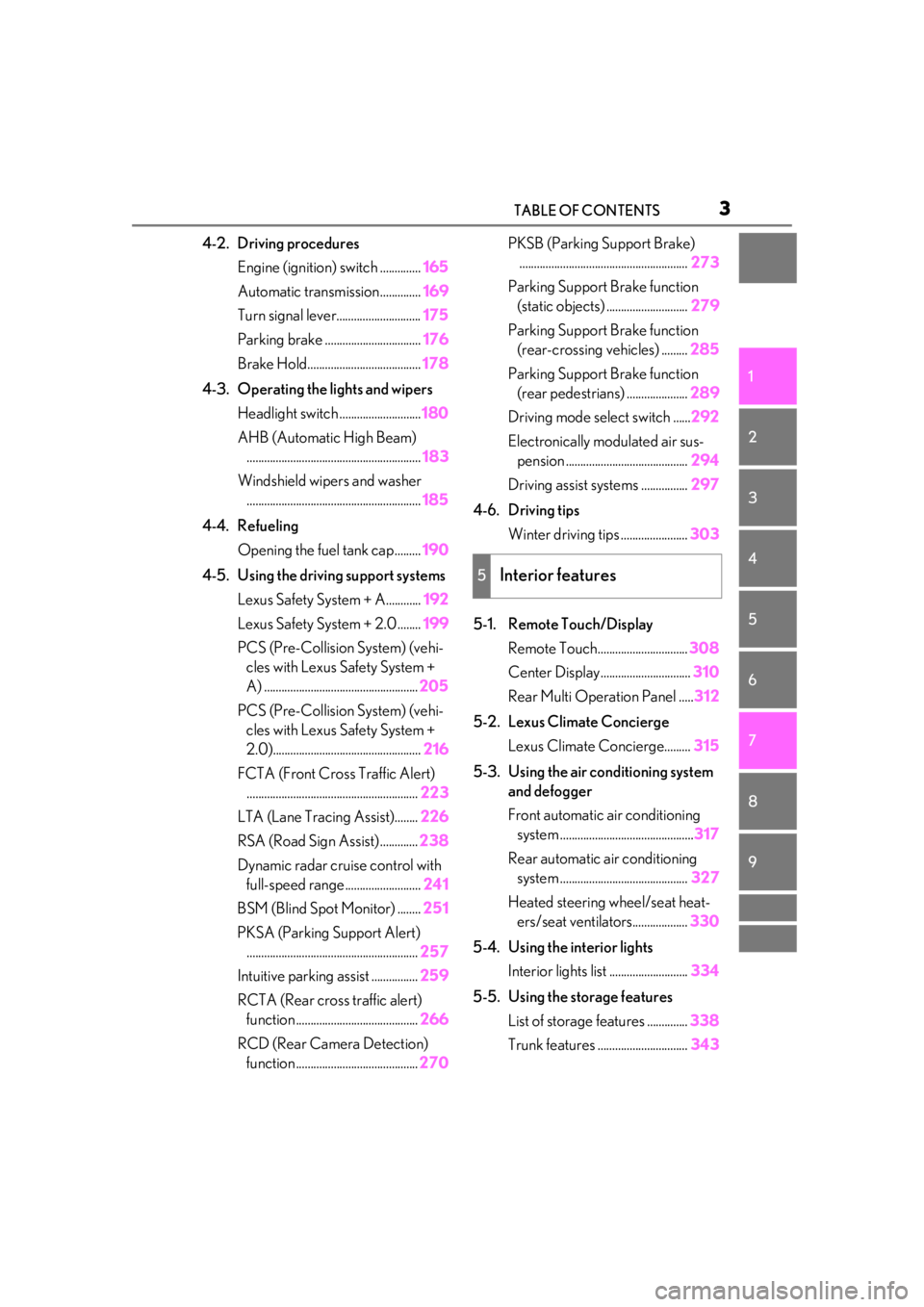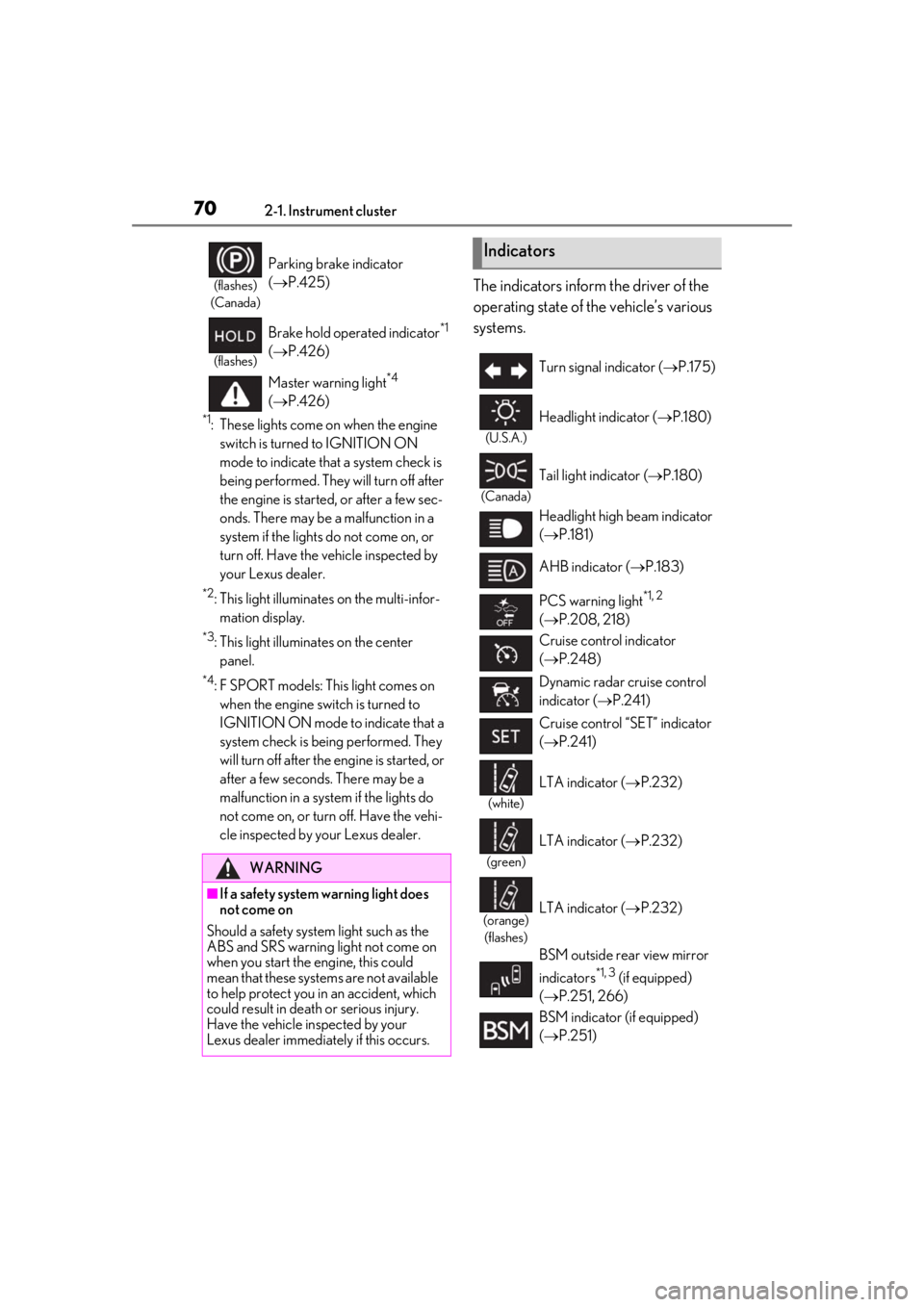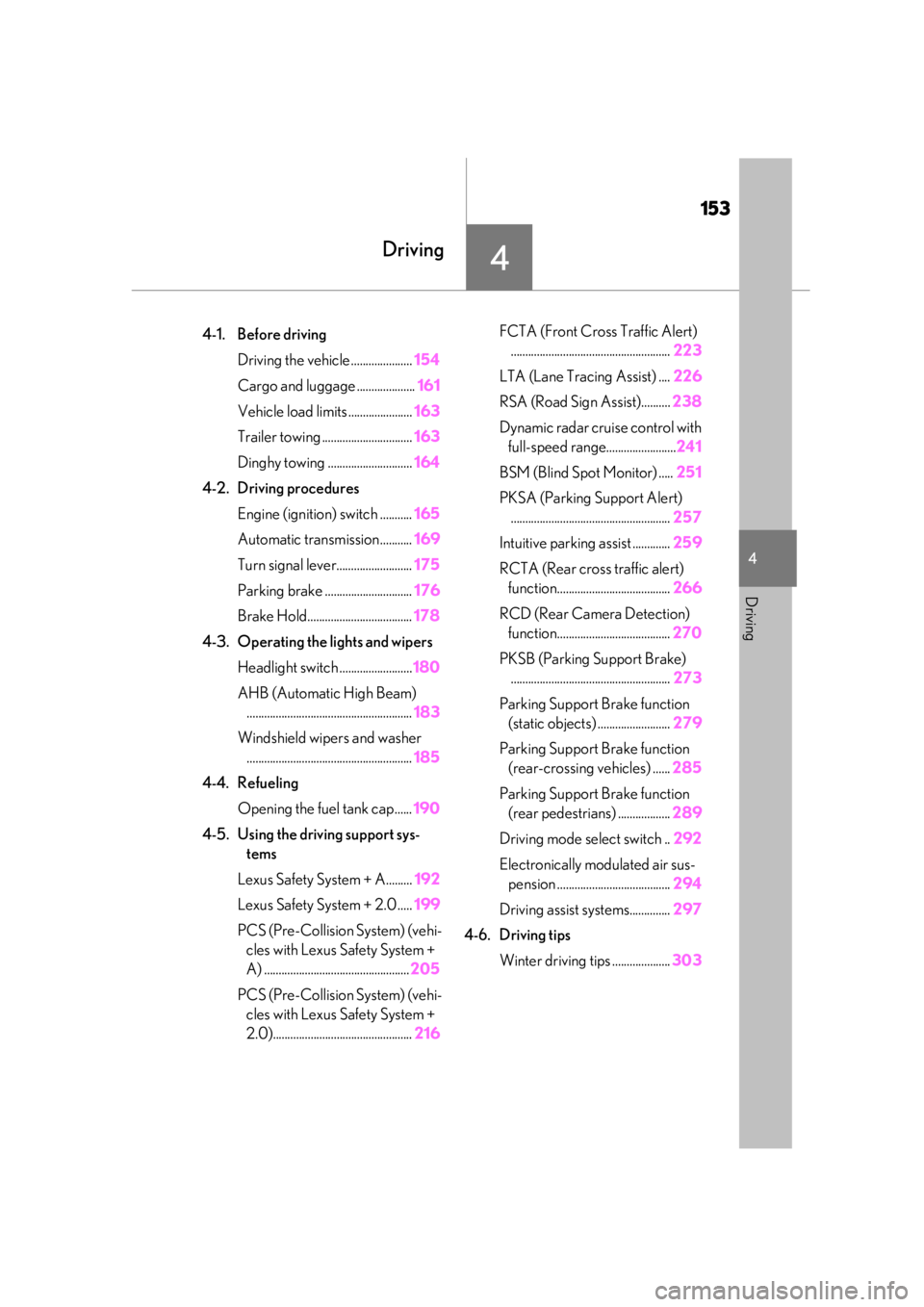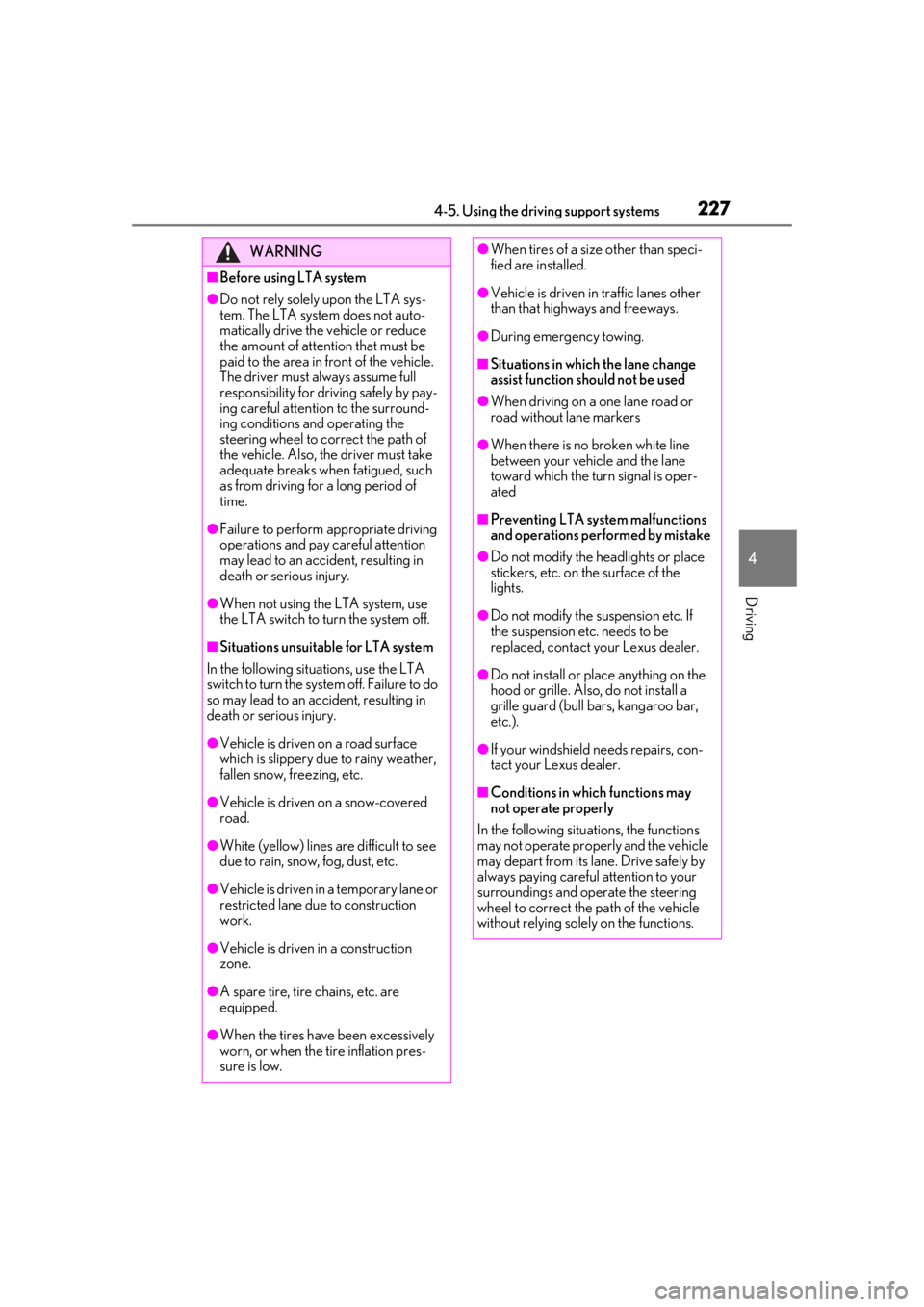turn signal LEXUS LS500 2020 Owners Manual
[x] Cancel search | Manufacturer: LEXUS, Model Year: 2020, Model line: LS500, Model: LEXUS LS500 2020Pages: 516, PDF Size: 10.38 MB
Page 3 of 516

3TABLE OF CONTENTS
1
2
3
4
5
6
7
8
9
4-2. Driving proceduresEngine (ignition) switch .............. 165
Automatic transmission.............. 169
Turn signal lever............................. 175
Parking brake ................................. 176
Brake Hold....................................... 178
4-3. Operating the lights and wipers Headlight switch ............................ 180
AHB (Automatic High Beam) ............................................................ 183
Windshield wipers and washer ............................................................ 185
4-4. Refueling Opening the fuel tank cap......... 190
4-5. Using the driving support systems Lexus Safety System + A............ 192
Lexus Safety System + 2.0 ........ 199
PCS (Pre-Collision System) (vehi- cles with Lexus Safety System +
A) ..................................................... 205
PCS (Pre-Collision System) (vehi- cles with Lexus Safety System +
2.0)................................................... 216
FCTA (Front Cross Traffic Alert) ........................................................... 223
LTA (Lane Tracing Assist)........ 226
RSA (Road Sign Assist) ............. 238
Dynamic radar crui se control with
full-speed range.......................... 241
BSM (Blind Spot Monitor) ........ 251
PKSA (Parking Support Alert) ........................................................... 257
Intuitive parking assist ................ 259
RCTA (Rear cross traffic alert) function .......................................... 266
RCD (Rear Camera Detection) function .......................................... 270PKSB (Parking Support Brake)
.......................................................... 273
Parking Support Brake function (static objects) ............................ 279
Parking Support Brake function (rear-crossing vehicles) ......... 285
Parking Support Brake function (rear pedestrians) ..................... 289
Driving mode select switch ......292
Electronically modulated air sus- pension .......................................... 294
Driving assist systems ................ 297
4-6. Driving tips Winter driving tips ....................... 303
5-1. Remote Touch/Display Remote Touch............................... 308
Center Display............................... 310
Rear Multi Operation Panel ..... 312
5-2. Lexus Climate Concierge Lexus Climate Concierge......... 315
5-3. Using the air conditioning system and defogger
Front automatic air conditioning system .............................................. 317
Rear automatic air conditioning system ............................................ 327
Heated steering wheel/seat heat- ers/seat ventilators................... 33
0
5-4. Using the interior lights Interior lights list ........................... 334
5-5. Using the storage features List of storage features .............. 338
Trunk features ............................... 343
5Interior features
Page 13 of 516

13Pictorial index
Precautions for winter season .....................................................................................P.303
To prevent freezing (windshield wiper de-icer)
*................................................. P.322
Precautions for car wash ............................................................................................... P.363
Fuel filler door ..........................................................................................................P.190
Refueling method .............................................................................................................. P .190
Fuel type/fuel tank capacity ...... .................................................................................... P.451
Tires.......................................................................................................................... ..P.387
Tire size/inflation pressure ............................ ................................................... P.387, 456
Winter tires/tire chains ..................................................................................................P.303
Checking/rotation/tire pressure warning system.............................................. P.387
Coping with flat tires........................................................................................................ P .433
Hood .......................................................................................................................... P.375
Opening ........................................................................................................................ ....... P.375
Engine compartment cover ......................................................................................... P.378
Engine oil ..................................................................................................................... ......... P.452
Coping with overheating ............................................................................................... P.444
Warning messages .......................................................................................................... P.429
Headlights/cornering lights ............................................................................... P.180
Parking lights/daytime running lights.............................................................. P.180
Turn signal lights ...................................................................................................... P.175
Tail lights ................................................................................................................... P .180
Stop lights
Hill-start assist control ....................................................................................................P. 298
License plate lights ................................................................................................ P.180
Back-up lights
Changing the shift position to R................................................................................... P.169
Side marker lights .................................................................................................. P.180
*:If equipped
Light bulbs of the exterior lights for driving
(Replacing method: P.408)
E
F
G
H
I
J
K
L
M
N
Page 15 of 516

15Pictorial index
Applying/releasing the parking brake.......................................................................P.176
Precautions for winter season .....................................................................................P.304
Warning buzzer/messages.......................................................................................... P.429
Turn signal lever ...................................................................................................... P.175
Headlight switch..................................................................................................... P.180
Headlights/parking lights/tail lights/license plate lig hts/daytime running lights
............................................................................................................................... .................... P.180
AHB (Automatic High Beam)...................................................................................... P.183
Windshield wiper and washer switch ................................................................P.185
Usage.......................................................................................................................... ............ P.185
Adding washer fluid .........................................................................................................P.3 84
Warning messages .......................................................................................................... P.429
Emergency flasher switch ....................................................................................P.410
Hood lock release lever ....................................................................................... P.375
Tilt and telescopic steering contro l switch................................ .................... .. P.139
Adjustment ..................................................................................................................... ...... P.139
Driving position memory ................................................................................................ P.130
Air conditioning system ........................................................................................ P.317
Usage.......................................................................................................................... .............P.317
Rear window defogger.....................................................................................................P.317
Audio system
*
Brake hold switch .................................................................................................... P.178
Trunk opener main switch ..................................................................................... P.110
*: Refer to “NAVIGATION AND MULTIMEDIA SYSTEM OWNER’S MANUAL”.
F
G
H
I
J
K
L
M
N
Page 70 of 516

702-1. Instrument cluster
*1: These lights come on when the engine switch is turned to IGNITION ON
mode to indicate that a system check is
being performed. They will turn off after
the engine is started, or after a few sec-
onds. There may be a malfunction in a
system if the lights do not come on, or
turn off. Have the vehicle inspected by
your Lexus dealer.
*2: This light illuminates on the multi-infor-mation display.
*3: This light illuminates on the center panel.
*4: F SPORT models: This light comes on when the engine switch is turned to
IGNITION ON mode to indicate that a
system check is being performed. They
will turn off after the engine is started, or
after a few seconds. There may be a
malfunction in a system if the lights do
not come on, or turn off. Have the vehi-
cle inspected by your Lexus dealer.
The indicators inform the driver of the
operating state of the vehicle’s various
systems.(flashes)
(Canada)
Parking brake indicator
( P.425)
(flashes)
Brake hold operated indicator*1
( P.426)
Master warning light
*4
( P.426)
WARNING
■If a safety system warning light does
not come on
Should a safety system light such as the
ABS and SRS warning light not come on
when you start the engine, this could
mean that these systems are not available
to help protect you in an accident, which
could result in death or serious injury.
Have the vehicle inspected by your
Lexus dealer immediately if this occurs.
Indicators
Turn signal indicator ( P.175)
(U.S.A.)
Headlight indicator ( P.180)
(Canada)
Tail light indicator ( P.180)
Headlight high beam indicator
( P.181)
AHB indicator ( P.183)
PCS warning light
*1, 2
( P.208, 218)
Cruise control indicator
( P.248)
Dynamic radar cruise control
indicator ( P.241)
Cruise control “SET” indicator
( P.241)
(white)
LTA indicator ( P.232)
(green)
LTA indicator ( P.232)
(orange)
(flashes)LTA indicator ( P.232)
BSM outside rear view mirror
indicators
*1, 3 (if equipped)
( P.251, 266)
BSM indicator (if equipped)
( P.251)
Page 114 of 516

1143-2. Opening, closing and locking the doors and trunk
engine is started or engine switch modes
are changed.
●Do not leave the electronic key on top of
the instrument panel or near the door
pockets when exiting the vehicle.
Depending on the radio wave reception
conditions, it may be detected by the
antenna outside the cabin and the doors
will become lockable from the outside,
possibly trapping the electronic key
inside the vehicle.
●As long as the electron ic key is within the
effective range, the doors may be locked
or unlocked by anyone. However, only
the doors detecting the electronic key
can be used to unlock the vehicle.
●Even if the electronic key is not inside the
vehicle, it may be possible to start the
engine if the electronic key is near the
window.
●The doors may unlock or lock if a large
amount of water spla shes on the door
handle, such as in the rain or in a car
wash, when the electronic key is within
the effective range. (The doors will auto-
matically be locked after approximately
60 seconds if the d oors are not opened
and closed.)
●If the wireless remote control is used to
lock the doors when the electronic key is
near the vehicle, there is a possibility that
the door may not be unlocked by the
entry function. (Use the wireless remote
control to unlock the doors.)
●Touching the door lock sensor while
wearing gloves may delay or prevent lock
operation.
●When the lock operation is performed
using the lock sensor, recognition signals
will be shown up to two consecutive
times. After this, no recognition signals
will be given.
●If the door handle becomes wet while the
electronic key is within the effective
range, the door may lock and unlock
repeatedly. In this case, follow the follow-
ing correction procedures to wash the
vehicle:
• Place the electronic key in a location 6 ft. (2 m) or more away from the vehicle.
(Take care to ensure that the key is not stolen.)
• Set the electronic key to battery-saving mode to disable the smart access system
with push-button start. ( P.113)
●If the electronic key is inside the vehicle
and a door handle becomes wet during a
car wash, a message may be shown on
the multi-information display and a
buzzer will sound outside the vehicle. To
turn off the alarm, lock all the doors.
●The lock sensor may not work properly if
it comes into contact with ice, snow, mud,
etc. Clean the lock sensor and attempt to
operate it again.
●A sudden approach to the effective
range or door handle may prevent the
doors from being unlocked. In this case,
return the door handle to the original
position and check that the doors unlock
before pulling the door handle again.
●If there is another electronic key in the
detection area, it may take slightly longer
to unlock the doors after the door handle
is gripped.
■When the vehicle is not driven for
extended periods
●To prevent theft of the vehicle, do not
leave the electronic key within 6 ft. (2 m)
of the vehicle.
●The smart access system with push-but-
ton start can be deactivated in advance.
●Setting the electronic key to battery-sav-
ing mode helps to reduce key battery
depletion. ( P.113)
■To operate the system properly
●Make sure to carry the electronic key
when operating the system. Do not get
the electronic key too close to the vehicle
when operating the system from the out-
side of the vehicle.
Depending on the position and holding
condition of the electr onic key, the key may
not be detected correctly and the system
may not operate properly. (The alarm may
go off accidentally, or the door lock pre-
vention function may not operate.)
●Do not leave the electr onic key inside the
trunk.
Page 153 of 516

153
4
4
Driving
Driving
.4-1. Before drivingDriving the vehicle ..................... 154
Cargo and luggage .................... 161
Vehicle load limits ...................... 163
Trailer towing ............................... 163
Dinghy towing ............................. 164
4-2. Driving procedures Engine (ignition) switch ........... 165
Automatic transmission........... 169
Turn signal lever.......................... 175
Parking brake .............................. 176
Brake Hold.................................... 178
4-3. Operating the lights and wipers Headlight switch ......................... 180
AHB (Automatic High Beam) ......................................................... 183
Windshield wipers and washer ......................................................... 185
4-4. Refueling Opening the fuel tank cap...... 190
4-5. Using the driving support sys- tems
Lexus Safety System + A......... 192
Lexus Safety System + 2.0 ..... 199
PCS (Pre-Collision System) (vehi- cles with Lexus Safety System +
A) .................................................. 205
PCS (Pre-Collision System) (vehi- cles with Lexus Safety System +
2.0)................................................ 216FCTA (Front Cross Traffic Alert)
....................................................... 223
LTA (Lane Tracing Assist) .... 226
RSA (Road Sign Assist).......... 238
Dynamic radar cruise control with full-speed range........................ 241
BSM (Blind Spot Monitor) ..... 251
PKSA (Parking Support Alert) ....................................................... 257
Intuitive parking assist ............. 259
RCTA (Rear cross traffic alert) function....................................... 266
RCD (Rear Camera Detection) function....................................... 270
PKSB (Parking Support Brake) ....................................................... 273
Parking Support Brake function (static objects) ......................... 279
Parking Support Brake function (rear-crossing vehicles) ...... 285
Parking Support Brake function (rear pedestrians) .................. 289
Driving mode select switch .. 292
Electronically modulated air sus- pension ....................................... 294
Driving assist systems.............. 297
4-6. Driving tips Winter driving tips .................... 303
Page 175 of 516

1754-2. Driving procedures
4
Driving
1Right turn
2 Lane change to the right (move the
lever partway and release it)
The right hand signals will flash 3 times.
3Lane change to the left (move the
lever partway and release it)
The left hand signals will flash 3 times.
4Left turn
■Turn signals can be operated when
The engine switch is in IGNITION ON
mode.
■If the indicator flashes faster than usual
Check that a light bulb in the front or rear
turn signal lights has not burned out.
■If the turn signals stop flashing before a
lane change has been performed
Operate the lever again.
■Customization
Some functions can be customized.
( P.470)Turn signal lever
Operating instructions
Page 182 of 516

1824-3. Operating the lights and wipers
1With the headlights on, push the
lever away from you to turn on the
high beams.
Pull the lever toward you to the center
position to turn the high beams off.
2Pull the lever toward you and
release it to flash the high beams
once.
You can flash the high beams with the
headlights on or off.
AFS (Adaptive Front-lighting System)
secures excellent visibility at intersec-
tions and on curves by automatically
adjusting the direction of the light axis
of the headlights according to vehicle
speed and the degree of the tire’s angle
as controlled by steering input.
AFS operates at speed s of approximately
6 mph (10 km/h) or higher.
■Customization
Some functions can be customized.
( P.470)
When the steering wheel or turn
signal lever is operated while the
headlights are on (low beam), a cor-
nering light will turn on and light up
the direction of movement of the
vehicle. The cornering lights are
designed to ensure excellent visibil-
ity when making a turn at an inter-
section.
However, when vehicle speed is more than approximately 22 mph (35 km/h), the cor-
nering lights will not turn on.
When the shift position is in R while
the headlights are on (low beam),
both cornering lights will turn on.
This is designed to enhance visibility
when parking.
■Cornering lights
When the cornering lights are on for more
than 30 minutes, they will turn off automati-
cally.
AFS (Adaptive Front-lighting
System) (if equipped)
Cornering lights
Page 184 of 516

1844-3. Operating the lights and wipers
●The high beams may be turned off if a
vehicle ahead that is using fog lights with-
out its headlights turned on is detected.
●House lights, street lights, traffic signals,
and illuminated billboards or signs and
other reflective objects may cause the
high beams to change to the low beams,
or the low beams to remain on.
●The following factors may affect the
amount of time taken for the high beams
to turn on or off:
• The brightness of the headlights, fog lights, and tail lights of vehicles ahead
• The movement and direction of vehicles ahead
• When a vehicle ahead only has opera-
tional lights on one side
• When a vehicle ahead is a two-wheeled vehicle
• The condition of the road (gradient, curve, condition of th e road surface, etc.)
• The number of passengers and amount of
luggage in the vehicle
●The high beams may turn on or off unex-
pectedly.
●Bicycles or similar vehicles may not be
detected.
●In the following situations the system may
not be able to correctly detect the sur-
rounding brightness le vel. This may cause
the low beams to remain on or the high
beams to flash or dazzle pedestrians or
vehicles ahead. In such a case, it is neces-
sary to manually switch between the high
and low beams.
• When driving in inclement weather
(heavy rain, snow, fog, sandstorms, etc.)
• When the windshield is obscured by fog, mist, ice, dirt, etc.
• When the windshield is cracked or dam-
aged
• When the camera sensor is deformed or dirty
• When the temperature of the camera sensor is extremely high
• When the surrounding brightness level is equal to that of head lights, tail lights or
fog lights
• When headlights or tail lights of vehicles ahead are turned off, dirty, changing
color, or not aimed properly
• When the vehicle is hit by water, snow, dust, etc. from a preceding vehicle
• When driving through an area of inter- mittently changing brightness and dark-
ness
• When frequently and repeatedly driving ascending/descending roads, or roads
with rough, bumpy or uneven surfaces
(such as stone-paved roads, gravel roads,
etc.)
• When frequently and repeatedly taking curves or driving on a winding road
• When there is a highly reflective object
ahead of the vehicle, such as a sign or
mirror
• When the back of a preceding vehicle is
highly reflective, such as a container on a
truck
• When the vehicle’s headlights are dam-
aged or dirty, or are not aimed properly
• When the vehicle is listing or titling due to a flat tire, a trailer being towed, etc.
• When the headlights are changed between the high beams and low beams
repeatedly in an abnormal manner
• When the driver believes that the high beams may be flashing or dazzling
pedestrians or other drivers
■Temporarily lowering sensor sensitivity
The sensitivity of the sensor can be tempo-
rarily lowered.
1 Turn the engine switch off while the fol-
lowing conditions are met.
●The headlight switch is in or .
●The headlight switch le ver is in low beam
position.
●Automatic High Beam switch is on.
2 Turn the engine switch to IGNITION
ON mode.
3 Within 60 seconds after step 2 , repeat
pushing the headlight switch lever to the
high beam position then pulling it to the
original position quickly 10 times, then
leave the lever in the original position.
4 If the sensitivity is changed, the AHB
indicator is turn on and off 3 times.
Automatic High Beam (headlights) may
turn on even when the vehicle is stopped.
Page 227 of 516

2274-5. Using the driving support systems
4
Driving
WARNING
■Before using LTA system
●Do not rely solely upon the LTA sys-
tem. The LTA system does not auto-
matically drive the vehicle or reduce
the amount of attention that must be
paid to the area in front of the vehicle.
The driver must always assume full
responsibility for driving safely by pay-
ing careful attention to the surround-
ing conditions and operating the
steering wheel to correct the path of
the vehicle. Also, the driver must take
adequate breaks when fatigued, such
as from driving for a long period of
time.
●Failure to perform appropriate driving
operations and pay careful attention
may lead to an accident, resulting in
death or serious injury.
●When not using the LTA system, use
the LTA switch to turn the system off.
■Situations unsuitable for LTA system
In the following situations, use the LTA
switch to turn the system off. Failure to do
so may lead to an acc ident, resulting in
death or serious injury.
●Vehicle is driven on a road surface
which is slippery due to rainy weather,
fallen snow, freezing, etc.
●Vehicle is driven on a snow-covered
road.
●White (yellow) lines are difficult to see
due to rain, snow, fog, dust, etc.
●Vehicle is driven in a temporary lane or
restricted lane due to construction
work.
●Vehicle is driven in a construction
zone.
●A spare tire, tire chains, etc. are
equipped.
●When the tires have been excessively
worn, or when the tire inflation pres-
sure is low.
●When tires of a size other than speci-
fied are installed.
●Vehicle is driven in traffic lanes other
than that highways and freeways.
●During emergency towing.
■Situations in whic h the lane change
assist function should not be used
●When driving on a one lane road or
road without lane markers
●When there is no broken white line
between your vehicle and the lane
toward which the turn signal is oper-
ated
■Preventing LTA system malfunctions
and operations performed by mistake
●Do not modify the headlights or place
stickers, etc. on the surface of the
lights.
●Do not modify the suspension etc. If
the suspension etc. needs to be
replaced, contact your Lexus dealer.
●Do not install or place anything on the
hood or grille. Also, do not install a
grille guard (bull bars, kangaroo bar,
etc.).
●If your windshield needs repairs, con-
tact your Lexus dealer.
■Conditions in which functions may
not operate properly
In the following situations, the functions
may not operate properly and the vehicle
may depart from its la ne. Drive safely by
always paying careful attention to your
surroundings and operate the steering
wheel to correct the path of the vehicle
without relying solely on the functions.